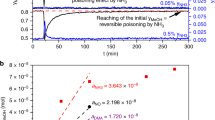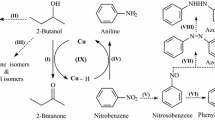Abstract
A method for quantifying the surface coverage of adsorbate species for reactions at high pressure and high temperature is presented. Methanol was synthesized from CO2/CO/H2 (3/29/68) at 523 K and 50 bar on Raney Cu, which yielded a turnover frequency (TOF) per Cu surface atom of (6.22 ± 1.04) × 10–3 s–1. Rapid quenching by submerging the catalytic reactor in ice water during operation allowed the formate surface coverage on Cu (θCu-HCOO) at reaction conditions to be determined in a subsequent temperature programmed desorption experiment. This yielded θCu-HCOO = 0.071 ± 0.012 ML and a corresponding TOF per adsorbed HCOO of 0.088 ± 0.021 s–1. CO2 was essentially observed to be the exclusive source of methanol formation over Raney Cu, as the CO in the syngas could be replaced by N2 without impact on the methanol formation rate. Based on this observation and the considerable support in the literature for a CO2-pathway via surface formate on Cu the TOF per surface formate species should represent the true rate of the catalytic cycle in Cu-catalyzed methanol synthesis. Temperature programmed hydrogenation of Raney Cu and unsupported Cu after quenching during high-pressure operation did not indicate a presence of oxygen species (O or OH) on the working Cu surface.
Graphic Abstract








Similar content being viewed by others
References
Sehested J (2019) Industrial and scientific directions of methanol catalyst development. J Catal 371:368–375. https://doi.org/10.1016/j.jcat.2019.02.002
Fujita S, Usui M, Ito H, Takezawa N (1995) Mechanisms of methanol synthesis from carbon dioxide and from carbon monoxide at atmospheric pressure over Cu/ZnO. J Catal 157:403–413. https://doi.org/10.1006/jcat.1995.1306
Amenomiya Y (1984) Infrared study of methanol synthesis from CO2 + H2 on supported copper-sinc oxide catalysts. In: Proceedings of the 8th International Congress on Catalysis, pp 557–567
Le Peltier F, Chaumette P, Saussey J et al (1998) In situ FT-IR and kinetic study of methanol synthesis from CO2/H2 over ZnAl2O4 and Cu–ZnAl2O4 catalysts. J Mol Catal A Chem 132:91–100. https://doi.org/10.1016/S1381-1169(97)00235-5
Lin S, Oldfield A, Klenerman D (2000) In-situ studies of polycrystalline copper during methanol synthesis at high pressure using sum frequency generation at surfaces. Surf Sci 464:1–7. https://doi.org/10.1016/S0039-6028(00)00706-8
Tarasov A, Seitz F, Schlögl R, Frei E (2019) In situ quantification of reaction adsorbates in low-temperature methanol synthesis on a high-performance Cu/ZnO: Al catalyst. ACS Catal 9:5537–5544. https://doi.org/10.1021/acscatal.9b01241
Nakamura I, Fujitani T, Uchijima T, Nakamura J (1996) A model catalyst for methanol synthesis: Zn-deposited and Zn-free Cu surfaces. J Vac Sci Technol 14:1464–1468. https://doi.org/10.1116/1.579970
Askgaard TS, Nørskov JK, Ovesen CV, Stoltze P (1995) A kinetic model of methanol synthesis. J Catal 156:229–242. https://doi.org/10.1006/jcat.1995.1250
Grabow LC, Mavrikakis M (2011) Mechanism of methanol synthesis on Cu through CO2 and CO hydrogenation. ACS Catal 1:365–384. https://doi.org/10.1021/cs200055d
Janse Van Rensburg W, Van Den Berg JA, Petersen MA et al (2015) On the kinetic interpretation of DFT-derived energy profiles: Cu-catalyzed methanol synthesis. Catal Lett 145:559–568. https://doi.org/10.1007/s10562-014-1407-1
Studt F, Behrens M, Schlögl R et al (2015) The mechanism of CO and CO2 hydrogenation to methanol over Cu-based catalysts. ChemCatChem 7:1105–1111. https://doi.org/10.1002/cctc.201500123
Tameh MS, Dearden AK, Huang C (2018) Accuracy of density functional theory for predicting kinetics of methanol synthesis from CO and CO2 hydrogenation on copper. J Phys Chem C 122:17942–17953. https://doi.org/10.1021/acs.jpcc.8b06498
Chorkendorff I, Taylor PA, Rasmussen PB (1992) Synthesis and hydrogenation of formate on Cu(100) at high pressures. J Vac Sci Technol A 10:2277–2281. https://doi.org/10.1116/1.577930
Chinchen GC, Waugh KC, Whan DA (1986) The activity and state of the copper surface in methanol synthesis catalysts. Appl Catal 25:101–107. https://doi.org/10.1016/S0166-9834(00)81226-9
Nielsen ND, Thrane J, Jensen AD, Christensen JM (2019) Bifunctional synergy in CO hydrogenation to methanol with supported Cu. Catal Lett. https://doi.org/10.1007/s10562-019-03036-7
Chinchen GC, Hay CM, Vandervell HD, Waugh KC (1987) The measurement of copper surface areas by reactive frontal chromatography. J Catal 103:79–86. https://doi.org/10.1016/0021-9517(87)90094-7
Chatterjee R, Kuld S, Van Den BR et al (2019) Mapping support interactions in copper catalysts. Top Catal 62:649–659. https://doi.org/10.1007/s11244-019-01150-9
Hinrichsen O, Genger T, Muhler M (2000) Chemisorption of N2O and H2 for the surface determination of copper catalysts. Chem Eng Technol 23:956–959. https://doi.org/10.1002/1521-4125(200011)23:11%3c956:AID-CEAT956%3e3.0.CO;2-L
Overbury SH, Bertrand PA, Somorjai GA (1975) The surface composition of binary systems. Prediction of surface phase diagrams of solid solutions. Chem Rev 75:547–560. https://doi.org/10.1021/cr60297a001
Laine J, Ceballos G, Severino F et al (1991) Structure and activity of a Raney copper film catalyst. Catal Lett 10:11–17. https://doi.org/10.1007/BF00764731
Li H, Belkind A, Jansen F, Orban Z (1997) An in situ XPS study of oxygen plasma cleaning of aluminum surfaces. Surf Coat Technol 92:171–177. https://doi.org/10.1016/S0257-8972(97)00079-0
Paparazzo E (1987) XPS and Auger spectroscopy on mixtures of the oxides SiO2, Al2O3, Fe2O3, and Cr2O3. J Electron Spectros Relat Phenom 43:97–112. https://doi.org/10.1016/0368-2048(87)80022-1
Rotole JA, Sherwood PMA (1998) Gamma-alumina (γ-Al2O3) by XPS. Surf Sci Spectra 5:18–24. https://doi.org/10.1116/1.1247852
Pan WX, Cao R, Roberts DL, Griffin GL (1988) Methanol synthesis activity of CuZnO catalysts. J Catal 114:440–446. https://doi.org/10.1016/0021-9517(88)90047-4
Argyle M, Bartholomew C (2015) Heterogeneous catalyst deactivation and regeneration: a review. Catalysts 5:145–269. https://doi.org/10.3390/catal5010145
Chinchen GC, Mansfield K, Spencer MS (1990) The methanol synthesis: how does it work. ChemTech 20:692–699
Nakamura I, Fujitani T, Uchijima T, Nakamura J (1996) A model catalyst for methanol synthesis: Zn-deposited and Zn-free Cu surfaces. J Vac Sci Technol A 14:1464–1468. https://doi.org/10.1063/1.451126
Yoshihara J, Parker SC, Schafer A, Campbell CT (1995) Methanol synthesis and reverse water-gas shift kinetics over clean polycrystalline copper. Catal Lett 31:313–324. https://doi.org/10.1007/BF00808595
Redhead PA (1961) Chemisorption on polycrystalline tungsten. Trans Faraday Soc 57:641–656. https://doi.org/10.1039/TF9615700641
Niemantsverdriet JW, Chorkendorff I (2003) Concepts of modern catalysis and kinetics. Wiley, New York
Iglesia E, Boudart M (1983) Decomposition of formic acid on copper, nickel, and copper-nickel alloys. I. Preparation and characterization of catalysts. J Catal 81:204–213. https://doi.org/10.1016/0021-9517(83)90158-6
Bowker M (1983) Chemisorption and industrial catalytic processes. Vacuum 33:669–685. https://doi.org/10.1016/0042-207X(83)90591-2
Bowker M, Hadden RA, Houghton H et al (1988) The mechanism of methanol synthesis on copper/zinc oxide/alumina catalysts. J Catal 109:263–273. https://doi.org/10.1016/0021-9517(88)90209-6
Yao Y, Zaera F (2016) Adsorption and thermal chemistry of formic acid on clean and oxygen-predosed Cu(110) single-crystal surfaces revisited. Surf Sci 646:37–44. https://doi.org/10.1016/j.susc.2015.06.007
Tamm S, Ingelsten HH, Skoglundh M, Palmqvist AEC (2010) Mechanistic aspects of the selective catalytic reduction of NOx by dimethyl ether and methanol over γ-Al2O3. J Catal 276:402–411. https://doi.org/10.1016/j.jcat.2010.10.004
Amenomiya Y (1979) Active sites of solid acidic catalysts III infrared study of the water gas conversion reaction on alumina. J Catal 57:64–71. https://doi.org/10.1016/0021-9517(79)90043-5
Ovesen CV, Clausen BS, Hammershøi BS et al (1996) A microkinetic analysis of the water-gas shift reaction under industrial conditions. J Catal 158:170–180. https://doi.org/10.1006/jcat.1996.0016
Zhang Z, Wang SS, Song R et al (2017) The most active Cu facet for low-Temperature water gas shift reaction. Nat Commun 8:488. https://doi.org/10.1038/s41467-017-00620-6
Berteau P, Ceckiewicz S, Delmon B (1987) Role of the acid-base properties of aluminas, modified γ-alumina, and silica-alumina in 1-butanol dehydration. Appl Catal 31:361–383. https://doi.org/10.1016/S0166-9834(00)80702-2
Taylor PA, Rasmussen PB, Ovesen CV et al (1992) Formate synthesis on Cu(100). Surf Sci 261:191–206. https://doi.org/10.1016/0039-6028(92)90231-T
Chinchen GC, Waugh KC (1986) The chemical state of copper during methanol synthesis. J Catal 97:280–283. https://doi.org/10.1016/0021-9517(86)90063-1
Chinchen GC, Spencer MS, Waugh KC, Whan DA (1987) Promotion of methanol synthesis and the water-gas shift reactions by adsorbed oxygen on supported copper catalysts. J Chem Soc Faraday Trans 1(83):2193–2212. https://doi.org/10.1039/f19878302193
Campbell CT (1987) Comments on: The activity and state of the copper surface in methanol synthesis. Appl Catal 32:367–369. https://doi.org/10.1016/S0166-9834(00)80641-7
Chinchen GC, Spencer MS, Waugh KC, Whan DA (1987) Reply to “comments on the activity and state of the copper surface in methanol synthesis catalysts [1]”. Appl Catal 32:371–372. https://doi.org/10.1016/S0166-9834(00)80642-9
Nakamura J, Rodriguez JA, Campbell CT (1989) Does CO2 dissociatively adsorb on Cu surfaces? J Phys Condens Matter 1:149–160. https://doi.org/10.1088/0953-8984/1/SB/026
Muhler M, Törnqvist E, Nielsen LP et al (1994) On the role of adsorbed atomic oxygen and CO2 in copper based methanol synthesis catalysts. Catal Letters 25:1–10. https://doi.org/10.1007/BF00815409
Ren Y, Yuan K, Zhou X et al (2018) Catalytic intermediates of CO2 hydrogenation on Cu(111) probed by in operando near-ambient pressure technique. Chem A Eur J 24:16097–16103. https://doi.org/10.1002/chem.201802931
Acknowledgements
This work was supported by the Villum Foundation Center for Science of Sustainable Fuels and Chemicals, Villum Foundation V-SUSTAIN Grant 9455.
Author information
Authors and Affiliations
Corresponding author
Additional information
Publisher's Note
Springer Nature remains neutral with regard to jurisdictional claims in published maps and institutional affiliations.
Electronic supplementary material
Below is the link to the electronic supplementary material.
Rights and permissions
About this article
Cite this article
Nielsen, N.D., Jensen, A.D. & Christensen, J.M. Quantification of Formate and Oxygen Coverages on Cu Under Industrial Methanol Synthesis Conditions. Catal Lett 150, 2447–2456 (2020). https://doi.org/10.1007/s10562-020-03162-7
Received:
Accepted:
Published:
Issue Date:
DOI: https://doi.org/10.1007/s10562-020-03162-7




